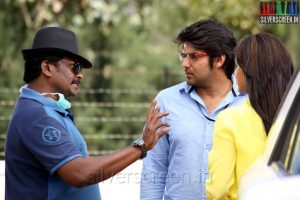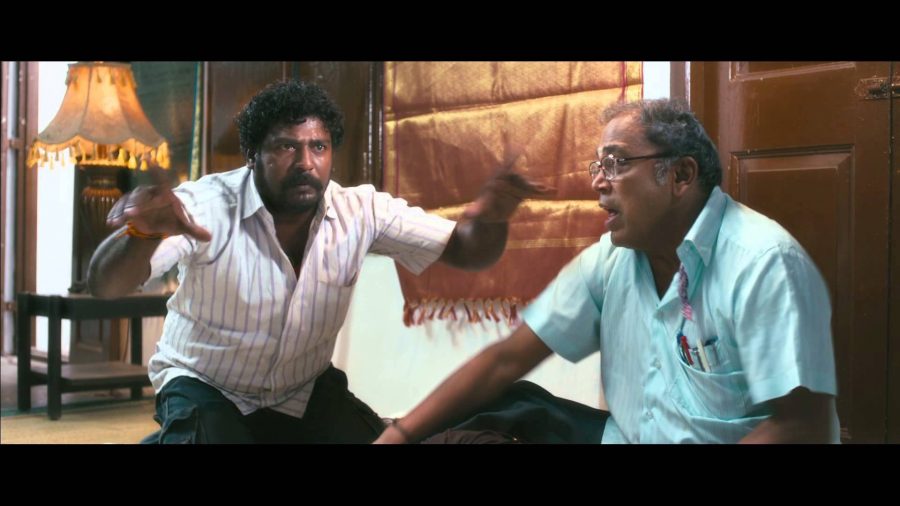
Actress Amala Paul, R Parthiepan and Arya in Kathai Thiraikathai Vasanam Iyakkam Movie Stills
His distinctive voice slowly and imperceptibly trickles into every frame, so much so that when he makes a fleeting appearance in between scenes, you hardly notice. You know that you have been listening to him all the while.
Kathai Thiraikkathai Vasanam Iyakkam follows the lives of a young filmmaker and his associates in search of a story. Through a narrative that is non-linear, and quite abstract at best; switching swiftly between two parallel worlds: one that belongs to the filmmakers, and one that belongs to their ideas.
The opening shot is of a giant Tsunami wave that leaves a trail of destruction in its wake. A lone survivor (Vishal) tries to stay aloft a severed tree branch, while a vulture greedily feeds on a carcass nearby. A child cries piteously. And the vulture responds with a doleful screech.
The next moment is of a cheerful guitar lesson in progress, brutally cut-short by a deafening blast. The teacher – a young woman – is then seen lying among the ruins, cradling the broken pieces of her guitar, as four threatening shadows loom over her. She slits her throat with a string.
The following instant, the camera is a stoic observer of a family, sitting over their meal. The father is berating his son (Vijay Sethupathi) about something, who then huffily walks over to his room and locks himself inside. A while later, the mother bursts in through the door, glances up at the ceiling and starts wailing. Indha fan-um pocha, she shrieks. An empty hook is seen dangling in the air.
Her son (steals and) sells fans for a living.
These tiny snatches, it later transpires, have no significance in the movie. The filmmaker and his team, were just brainstorming ideas.
The most fascinating scenes in KTVI belong to the filmmaker’s wife (Akhila Kishore in an exciting role). The strong female protagonist who is demure only to the eye. She’s a delight to watch. And her appearance is a tale unto itself. In those strong fits of passion or rage, she has an angry red smudge on her forehead (otherwise seen as a modest bindi); dark, brooding eyes and hair that snakes down past her waist.
She supports her husband who is yet to assert himself in the industry, is a strange amalgamation of Gowri from Puthu Puthu Arthangal and Sindhu from Sindhu Bhairavi, and is quite the child at heart. Parthiban takes immense pride in shaping his protagonists: of the female kind. She’s also called ‘eccentric’, but serves as an ‘inspiration’ to her husband all the same, who crafts his story around her. And, she’s called Dakshaa. A name well-steeped in mythology (an embodiment of the universal female energy, Shakti).
Parthiban is also quite rigid about staying true to KTVI’s tag line: A film without a story. So rigid that, during the second half, when there’s a semblance of a tale that begins to unfold, it is duly snatched away from us. It’s more like a disorganized diary of the director’s journey: a bizarre documentary of sorts, with several vignettes that quickly flash by.
Recommended
There’s drama ala a Tamil soap (with Dakshaa flinging her thaali at her husband), a Sliding Doors moment, and a suicide nonetheless, all nimbly stitched together. Then, there are Parthiban’s cameo appearances, where he sometimes offers a glimpse into the future (a bold move, this), and sometimes is just content merely commenting on the proceedings. During a particular instance, he snatches a paper out of thin air – the one from which Thamizh has just read a verse of poetry – and calls out a mispronunciation. Naandhanga ezhudi koduthen. Thappa padicha, ezhudina enakku kovam varuma varadha?
But all these quirky moments aside, what lingers on, much after the movie ends, are those beautifully-painted women. Dakshaa, Yazhini (Amala Paul in an interesting cameo), and Deepa – the director’s muse. So much so that we can’t seem to recall what Santhosh Prathap is called in the movie.
And, we had to Google to find out.
The Kathai Thiraikkathai Vasanam Iyakkam review is a Silverscreen original article. It was not paid for or commissioned by anyone associated with the movie. Silverscreen.in and its writers do not have an advertising relationship with movies that are reviewed on the site.



